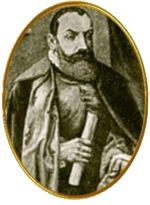Patron
 Jan Kochanowski (born in 1530 in Sycyna near Puławy, died on 22 August 1584 in Lublin) - prominent Polish poet of the Renaissance period, royal secretary, parish priest of Poznań and Zvolen. He came from the noble Kochanowski family of the Korwin coat of arms, and was the son of Piotr Kochanowski, a Sandomierz land judge, and Anna Białaczowska of the Odrowąż coat of arms.
Jan Kochanowski (born in 1530 in Sycyna near Puławy, died on 22 August 1584 in Lublin) - prominent Polish poet of the Renaissance period, royal secretary, parish priest of Poznań and Zvolen. He came from the noble Kochanowski family of the Korwin coat of arms, and was the son of Piotr Kochanowski, a Sandomierz land judge, and Anna Białaczowska of the Odrowąż coat of arms.
Education and travel
He began his studies at the Krakow Academy in 1544. Between 1547 and 1550, he may have studied at any of the German universities or stayed at one of the magnate's courts. From 1551 to 1552, he studied at the University of Königsberg, from where he went to Italy, to Padua. At the university there, he came into contact with such minds as Francesco Robortelo, as well as with the Poles studying there: Łukasz Górnicki, Andrzej Trzecieski and Andrzej Patrycy Nidecki. At the University of Padua, he even became a consigliere of the Polish nation, arguing for independence with the German students. His studies, travels and contacts with scholars and humanists gave Kochanowski philological and humanistic knowledge as well as literary refinement and skill. He had already written minor works in Latin in Italy. Song XXV (What wilt thou have of us, O Lord, for thy generous gifts) was also written in that period. Between 1555 and 1556 he was again in Königsberg at the court of Archduke Albrecht Hohenzollern, before making two further trips to Italy between 1556 and 1559. From there, by way of France (where he came into contact with Ronsard) and Germany, he returned to Poland for good.
Activities at Polish courts
In the country, he stayed at courts including such as the Tarnowski, Tęczyński and Jan Firlej courts, as well as the Bishop of Kraków, Filip Padniewski. Thanks to the support of the Deputy Chancellor of the Crown, Piotr Myszkowski, he got to the court of Sigismund August, where around 1564 he was appointed royal secretary. Thanks to Myszkowski, he also received church prebends: the rectory of Poznań and Zwoleń. He served the king during stormy assemblies and was involved in political activities, traces of which can be seen in his works. In 1567, he accompanied the king on the Radoskovich expedition, an attempted armed demonstration against Russia. He rendered considerable services during the preparations for the expedition to Moscow in 1568. He served at the court of Sigismund II Augustus until 1574. He described important events for the Republic, including the Prussian homage of Duke Albrecht II Friedrich of Hohenzollern at the feet of Sigismund II Augustus, the union of the Crown and Lithuania (1569). After the death of Sigismund Augustus, he was a supporter of Henry of Valois, whose election he signed, and also attended his coronation at Wawel Cathedral in 1573. After the King's flight, he withdrew from court life. He never returned to the royal court, although he supported Stefan Batory; he took part in the Electoral Sejm and won the favour of Chancellor Jan Zamoyski.
Czarnolas
In 1574, he settled on the estate he inherited from his father in Czarnolas (Black Forest). In 1575 he married Dorota Podlodowska of the coat of arms Janina, with whom he had six daughters (three died in childhood) and a son (born after Jan's sudden death). Kochanowski lived the bucolic life of a landowner in Czarnolas. In May 1575, he took part in a convention of the nobility in Stężyca, which deliberated on the election of a new ruler. In November that year, he gave a speech on the electoral field near Warsaw. This period saw the writing of The Dismissal of the Greek Envoys, soon followed by the paraphrase David's Psalter (1579), taken from the Vulgate. He is best remembered for his Laments, written after the death of his beloved daughter Urszula Kochanowska in 1579. In his laments, he described his deceased daughter Ursula as an ideal child. He wrote that she sang and composed short poems. He died suddenly of a heart attack in Lublin on 22 August 1584. He was buried in Zwolen, near which Czarnolas lies. There is a gravestone there with one of the two surviving images of the poet.










